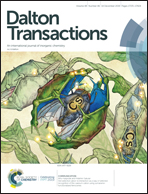Functional construction of a water-stable Tb-coordination polymer luminescent sensor for highly selective detection of picric acid in an aquatic environment†
Abstract
In order to achieve the goal of convenient and efficient detection of picric acid in a water environment, based on function-oriented research ideas, we combine luminescence performance with recognition performance, taking into account the application conditions. Urea sites with picric acid selective recognition properties and lanthanide ions with luminescence properties are introduced into the recognition system in a pure water environment and a new 2D luminescent coordination polymer was synthesized. A series of luminescence recognition tests prove that TbL exhibited high sensitivity, good selectivity and fast response towards PA in a pure water environment. Particularly, TbL can not only be simply and quickly regenerated, but also be applied to the detection of PA in river water and tap water, again showing excellent recognition performance. Thus, TbL can be used as an efficient luminescent sensor in the water environment for PA detection. In addition, this work also provides a reference for the future design of novel lanthanide luminescent sensors using function-oriented strategies.



 Please wait while we load your content...
Please wait while we load your content...